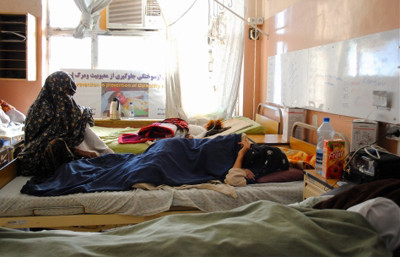IRIN, July 1, 2013
Increased fighting takes toll on health care in Afghanistan
Insecurity and lack of funding prevented 540 health centres across the country from either opening or carrying on with their normal daily activities
It is close to midday and a group of patients wait outside the Mirwais regional hospital in southern Afghanistan’s Kandahar city.
“There are no health clinics in our district so I have to come this long way for treatment. I have not met the doctor yet and have been waiting to see him for a long time,” one man, who had been waiting since sunrise and had driven four hours from neighbouring Helmand Province, told IRIN.
According to health NGO Emergency, war-related admissions to their health facilities are up 42 percent in the first four months of 2013 on the same period last year, with the situation particularly bad in Helmand, which saw an increase of nearly 80 percent.
The figures correspond with accounts of increased violence from both the Afghanistan NGO Safety Office (ANSO) and the UN Assistance Mission in Afghanistan (UNAMA).

The women's ward at Mirwais regional hospital in Kandahar city. (Photo: Bethany Matta/IRIN)
According to ANSO, the number of attacks by the armed opposition increased by 47 percent from January to March of this year, marking a return to the levels of violence seen in 2011, the highest on record.
UNAMA figures show a 13 percent increase in civilian casualties in the second half of 2012 compared to the same period in the previous year. The increasing use of Improvised Explosive Devices (IEDs) is a key cause of civilian injuries.
The violence is leading not just to a greater demand on medical services but also a climate of insecurity for health staff.
“The number of war-related cases we are receiving at Mirwais has definitely increased in the past four months,” hospital director Farhad Dawod told IRIN.
“Until now our staff has not been threatened but they don't feel comfortable within the community because there's no peace. The attacks terrorize people.”
Mirwais deals with 500-600 outpatients a day, sees 3-4 maternal deaths a month, and has a bed occupancy rate of 87-90 percent for adults, and 105 percent for children in the Intensive Care Unit, meaning sometimes three sick children share the same bed.
According to the country’s humanitarian health cluster, which brings together NGOs and UN agencies working in the sector, Kandahar is one of nine provinces (out of 34) that have seen a 40 percent increase in security incidents involving public health facilities, staff and patients.
Health facilities and outreach programmes have also had to stop their activities in some areas due to fighting and insecurity along the roads.
More non-functioning health facilities
In February the World Health Organization (WHO) reported a 40 percent increase in the number of non-functioning health facilities in 2012 compared to the previous year.
Insecurity and lack of funding prevented 540 health centres across the country from either opening or carrying on with their normal daily activities.
In turn, said the report, the suspension or closure of the health facilities was a main contributing factor to the 283 cases of disease outbreaks WHO handled in the first 10 months of 2012.
“The hospitals in the southwest part of the country are better off than those in other parts of the country,” said Dawod. But “as you can see, even in Kabul they don't have basic medicine and health care for patients.”
While attacks have picked up in Kabul, particularly over the past month, doctors working in government hospitals in the capital told IRIN they have not been affected by the overall increase in violence. But they said they are still facing the same chronic shortages, as in the past.
“Hospitals in Kabul have not experienced any noticeable differences [as violence across the country increases], but there is no doubt we are facing many problems regarding quality and standardization of health services,” intensive care specialist Ajmal Mushkanny, who works in both a private and a government-run emergency hospital in Kabul, told IRIN.
“There are plenty of medical staff in Kabul, but the problem is finding those with the right level of qualifications.”
Medical care for women
Female civilian casualties in 2012 were up 20 percent compared to the year before, according to UNAMA, but health centres and hospitals struggle with a shortage of qualified female staff.
“Poor health services and a lack of female staff and doctors have a big impact on our activity with children and maternal care,” said Dawod. “Our lack of qualified female staff, especially obstetrician/gynaecologist doctors, has greatly affected us, increasing our maternal mortality rate.”
Female health workers, including unqualified support staff, make up 28 percent of the workforce in the country, according to a joint health report, but they are concentrated in midwifery and community health work.
Despite gains in maternal mortality, Afghanistan is still among the world’s toughest countries to be a mother, with only 40 percent of births assisted by trained medical personnel, according to WHO.
The UN Office for the Coordination of Humanitarian Affairs (OCHA) says that in the first five months of this year, the health sector was able to assist 708,000 people with emergency services (out of the 1.6 million people targeted for interventions this year).
Characters Count: 6744
